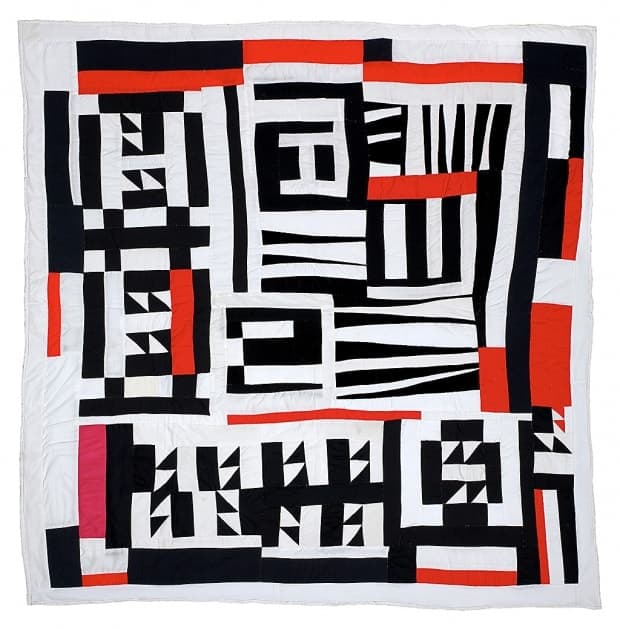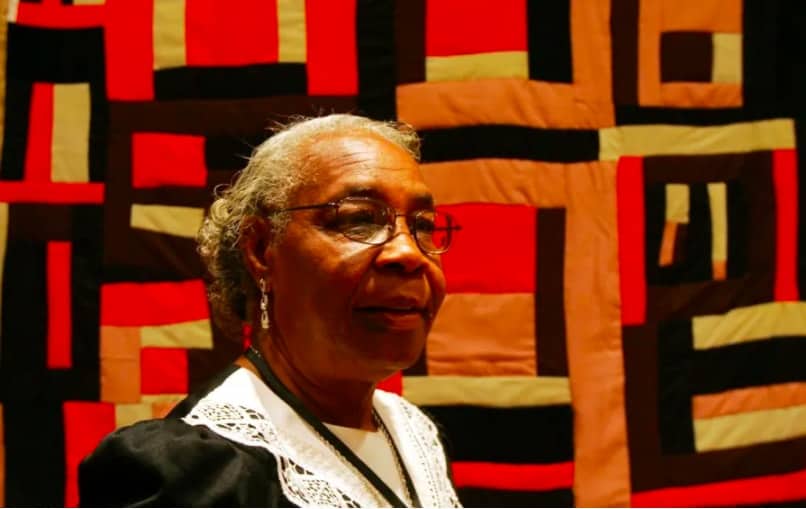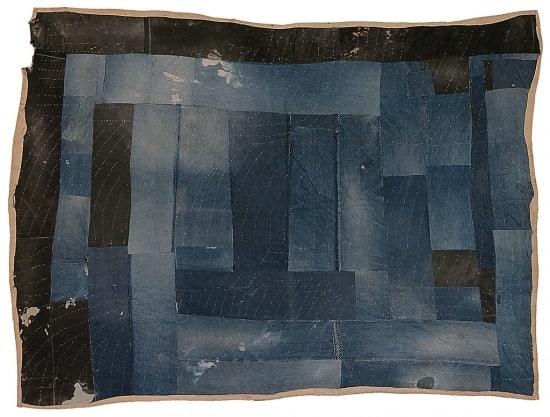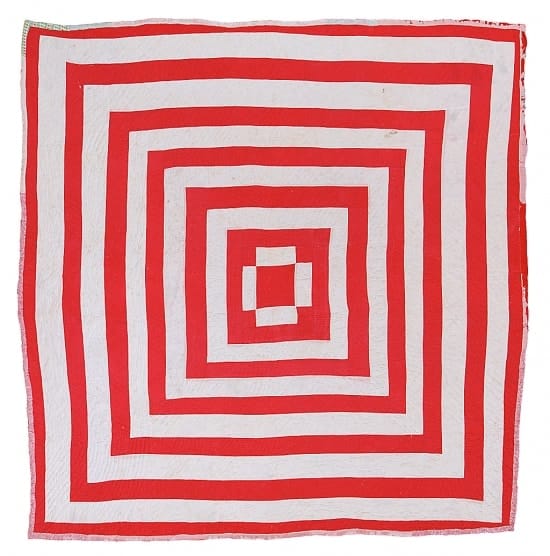Articles & Features
The Gee’s Bend Quiltmakers: A Modernist Art with Folk Traditions

By Tori Campbell
“The best of these designs, unusually minimalist and spare, are so eye-poppingly gorgeous that it’s hard to know how to begin to account for them. But then, good art can never be fully accounted for, just described…””
Michael Kimmelman, New York Times’ ART REVIEW; Jazzy Geometry, Cool Quilters, 2002
Folk Traditions in Art
Modern art history often has a revisionist bent, seeking to correct art historic mistakes or to comport a more inclusive attitude to embrace artistic output from the margins. There is great pleasure to be found in uncovering and exploring the work of artists without the conventional training we associate with the establishment or canon – folk artists steeped in vernacular traditions, steadily and carefully passing down their techniques from generation to generation, or outsider artists with visionary self-taught modes of expressions. With skills used for both craft and necessity, these artists give birth to artistic movements and innovative new aesthetics. In some cases the artists, like the Gee’s Bend Quiltmakers we explore here, do not even determine to create art or consider their work as such until they see their work on the walls of museums. Join us in the Deep South to hear their story and see their work.
What is Gee’s Bend?
In 1859 a woman named Dinah was torn from her home in Africa and taken to the United States, to be sold for a dime to a man named Pettway. Pettway would bring her to Gee’s Bend, Alabama, where she and her fellow slaves on his plantation became known as their owner’s property, and forced, as was the convention, to adopt his surname. Though not all Pettways of Gee’s Bend are blood-related, the community is small — located on a rural and isolated bend in the Alabama River in the Black Belt of the southern United States. Gee’s Bend comprises less than three hundred inhabitants, most of which are descendents of Pettway’s slaves, with about half of all residents bearing the name or origin.

In the 1930’s the community was struggling when the price of cotton dropped nearly overnight, and creditors came to collect. Gee’s Bend was reduced to abject poverty, and as the nation’s poorest community the government stepped in to provide housing and farm plots at affordable prices with low interest rates. The aid scheme allowed African American families the opportunity to own land for the first time, and contributed greatly to the demographic makeup of the town today.

(AP Photo / Chitose Suzuki)
Who are the Gee’s Bend Quiltmakers?
Dinah’s granddaughter, Arlonzia Pettway, began sewing quilts when she was 13 years old. She learned to sew from her mother, who had also inherited the methodology, and in so doing joined a long lineage of female quiltmakers that likely has origins beyond the 19th century. The group of women recognised today as the Gee’s Bend Quiltmakers is composed of three to four generations of women that have created hundreds of quilts from the mid-nineteenth century to the present. Nearly all of the Gee’s Bend women began quilting as children, and many have cited their primary motivation was to keep themselves and their children warm in the unheated homes in which they lived. From a purely cultural standpoint, the work of these women is exceptional for many reasons, among which is the social and geographic isolation in which the creations took place — providing an unprecedented degree of cultural continuity in a community in which the folk traditions were passed down from grandmother or mother to daughter.
The Artistry of Gee’s Bend Quilts
From an artistic and aesthetic standpoint, the quilts embody several distinctive styles, outlined in the following different categories: abstract & improvisation; housetop & bricklayer; pattern & geometry; Sears corduroy; and work clothes.
Abstract & Improvisation Quilts

Most of Gee’s Bend quilts can be characterised as abstract & improvisation quilts, or ‘my way’ quilts, in that they are guided by the desires and passions of their creator. Often unorthodox in their patterns, or with no pattern at all, these quilts reflect the whims of the women who made them — guided by a love of a particular colour or cloth.
Housetop or Bricklayer Quilts

Evocative of the African American musical tradition of call and response, housetop patterning is a favorite technique of the Gee’s Bend quiltmaking group. The housetop, or bricklayer, quilt can be thought of as a guiding concept more than anything else, beginning with a piece of solid cloth, or one comprised of many components; to anchor the rest of the piece. Then rectangular strips of cloth join at one strip’s long side ad the other’s short, forming a framing around the central patch, adding more and more until the piece is deemed complete.
Geometric Quilts

The Gee’s Bend quilts of the early 20th century are largely geometrically intricate pieces, comprised of many pieces of cloth in repeating patches of triangles, squares, diamonds, or hexagons. These works are testaments to the artistry that evolved from everyday life in the rural area — an outpouring of creation stemming from a necessary object — a blanket to keep a family warm.
Sears Corduroy Quilts

In the 1970s the Freedom Quilting Bee, a cooperative Civil Rights group based near Gee’s Bend worked with retailer Sears & Roebuck to produce corduroy pillow cases. The fabric came in a few distinctive colours, that by way of scraps and reuse, began to find itself in the work of Gee’s Bend quilts very quickly. The distinctive yellow, green, orange, and red corduroy spurred a creative outpouring which resulted in numerous corduroy quilts, a novel fabric at the time.
Workwear Quilts

Perhaps the most famous, and most unique, of Gee’s Bend quilts are the workwear quilts. Born out of scarcity and poverty, workwear quilts are the result of years of hard times and the simple need to stay warm. These quilts are patchwork pieces borne from the resourcefulness of salvaging fabric scraps from worn out utilitarian clothing. The fabric, already having lived a hard life and no longer functional is repurposed from its residual pieces. These works are exceptional works of art in that they are both reflections of the spirit of the community and its prevailing socio-economic conditions of the moment. Until at least the mid-twentieth century the quilts of Gee’s Bend were largely workwear quilts, reflective of the hardship the area experienced in the 1930s, and the former slave status of the residents. The fabrics of the workwear quilts; stained aprons, worn denim, and torn dresses are a tangible reflection of the lives marked by the hard labor of cotton picking in the fields of the Southern United States. These quilts, more so than any others, are perfectly preserved remnants of a past time; artworks undiluted by other cultures and unique to the isolation, remoteness and hardship that necessitated their creation.
The Renown of Gee’s Bend Quilts

It was these qualities that lead art historian William (or Bill) Arnett, to Gee’s Bend after seeing one of Annie Mae Young’s quilts in a book. Determined to track down its creator Arnett found his way to Gee’s Bend, where he ended up becoming inextricably linked to the quiltmakers themselves. After seemingly helping to catapult the women into the art world and an ensuing mainstream commercial success, Arnett could be construed as an archetypal and problematic “white saviour” figure, making efforts to set the women up with a foundation and organisational structure within which to sell their own products. However, he also ended up embroiled in a lawsuit filed by key quilters Annie Mae Young and Loretta Pettway, two of the most prominent figures in Gee’s Bend, alleging that he had pocketed large sums from sales of their quilts. Several articles could be written on this controversy alone, but regardless of the financial implications behind his involvement, Arnett’s influence led the quilts of Gee’s Bend into museums around the world. With quilts hanging across the country in influential institutions including the Whitney Museum of American Art, Philadelphia Museum of Art, Metropolitan Museum of Art, and numerous others; the work has been lauded as among the finest examples of American modernist art in existence.
The pieces have been described as surprisingly minimalist works, yet lyrical and jazzy with their wavy stitches overlaid onto improvisational patterns. Alvia Wardlaw, curator of Modern and Contemporary Art at the Museum of Fine Arts, Houston proclaimed that “the compositions of these quilts contrast dramatically with the ordered regularity associated with many styles of Euro-American quiltmaking. There’s a brilliant, improvisational range of approaches to composition that is more often associated with the inventiveness and power of the leading 20th-century abstract painters than it is with textile-making.” But the most compelling and lasting reviews came from New York Times’ Michael Kimmelman, who raved “Imagine Matisse and Klee (if you think I’m wildly exaggerating, see the show) arising not from rarefied Europe, but from the caramel soil of the rural South in the form of women, descendants of slaves when Gee’s Bend was a plantation.”
Relevant sources to learn more
View more of their work at Souls Grown Deep
Check out this free documentary from PBS
Read the original exhibition review from the New York Times
Enjoy some other artist documentaries